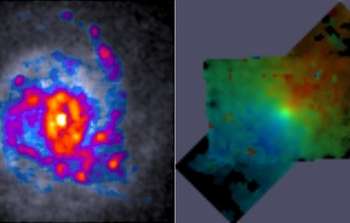sci15060 — Announcement
Low Spin Produces Clumpy Galaxies
December 16, 2015
The massive star-forming galaxies of this study have clumpy, turbulent gas. Integral field spectroscopy with GMOS and other instruments yielded kinematic measurements.
A team of Australian researchers used two Maunakea-based observatories – Gemini North and W. M. Keck Observatory – to discover why some galaxies are clumpy rather than spiral. They concluded that low specific angular momentum is primarily responsible for the clumpiness (and corresponding star formation) rather than large amounts of gas as previously suggested. Danail Obreschkow (International Centre for Radio Astronomy Research, University of Western Australia) led the research which also suggests that angular momentum is the key difference between more distant (z~2) clumpy galaxies similar to the low-redshift sample of this work, and spiral galaxies in the local universe. More information is posted on the Gemini web page, and full results are published in The Astrophysical Journal.
About the Announcement
| Id: |
ID
sci15060
|
